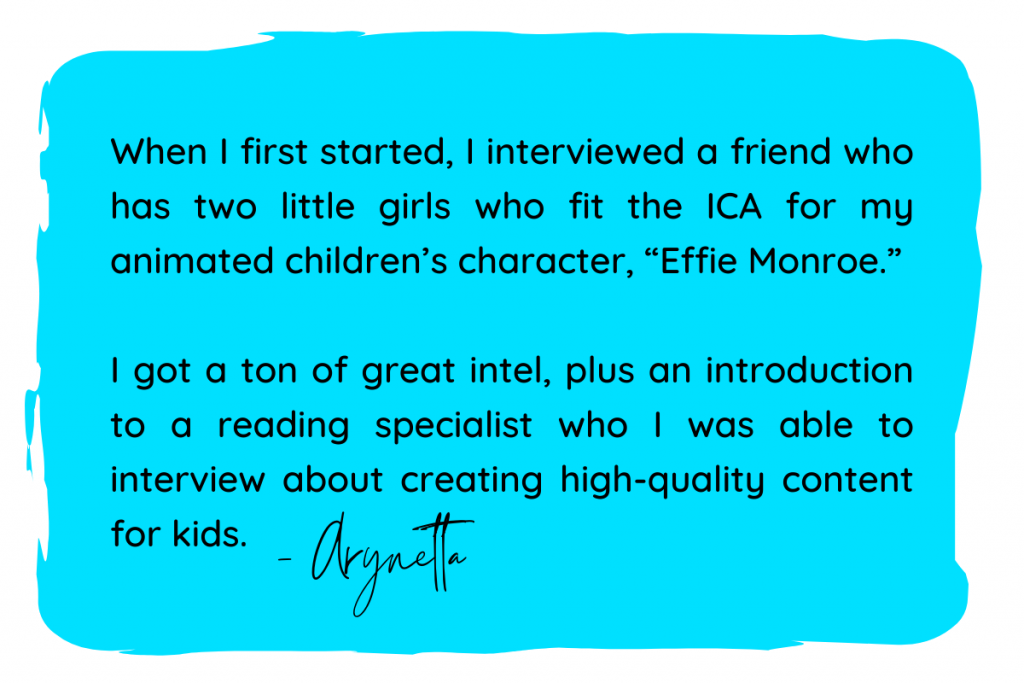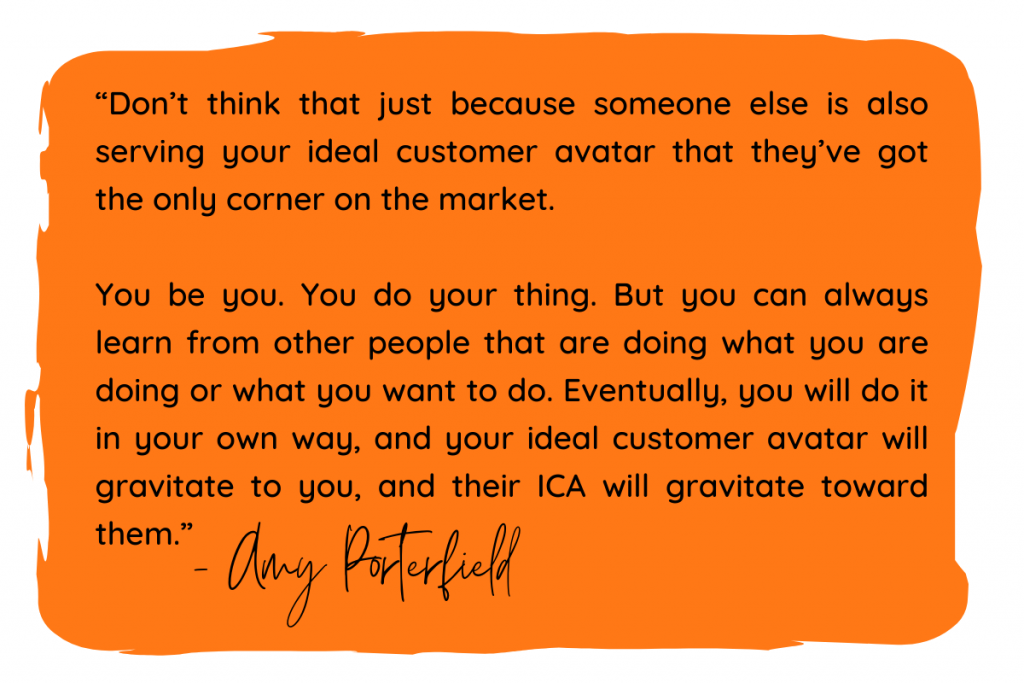How to Create an Ideal Customer Avatar (ICA) in 4 Easy Steps

It’s one of the hottest topics in the online business space––content creation.
You create content for your blog, videos, newsletter, social media, podcast, Patreon, plus all of the one-and-done (or, at least, minimally-updated) content you create with your courses, lead magnets, and autoresponder sequences.
But, here’s the question. Who are you creating all of that content for?
Your customers, right?
Right. But do you know exactly who that customer is? Because if you don’t, much of your effort may be falling through the cracks.
To create powerful courses, ad copy, and content, you need to know exactly who you’re speaking to and creating these courses for. You have to know how to serve them, specifically, in everything you do.
And, today, you’re going to learn how to do just that.
We’re going to get specific with ICAs––your Ideal Customer Avatar.
We’ll teach you what an Ideal Customer Avatar is, why you need one, and how to create your own in four simple steps (complete with a downloadable worksheet).
Let’s get started.

What is an Ideal Customer Avatar anyway?
At its simplest, your Ideal Customer Avatar, or ICA, is a fictional representation of your ideal customer. It’s a character that you create with all of the demographic and psychographic characteristics that the customer you’d most like to work with, and who would most like to work with you, possess.
And, not to be overstated, this is your ideal.
It’s not the customer you think you could get, or the customer you hope you could get, or that you would need to slash all of your prices to get.
Your ICA represents your dream client that is looking for you, your products, and your services as much as you are looking for them (no price-slashing necessary).
It’s a match made in heaven. They are your absolute ideal.
Once you have nailed down this ideal customer, you’ll be able to speak directly to them in all of your marketing and content.
Why is this important?
As entrepreneur Meredith Hill says, “When you speak to everyone, you speak to no one.”
Without clarity on who you’re trying to reach with your messaging, you run the risk of being generic, which is ultimately ineffective.
When you have an ICA, you’re able to craft your message intentionally and specifically, with your audience in mind.
Harvard Professor Gerald Zaltman reported that 95 percent of decisions are made on the subconscious level. And the largest subconscious driver? Emotions.
Reaching your customer emotionally is one of the best ways to improve your marketing and content’s ROI.
Your ICA is going to help you to do just that. Creating your ICA will help you reach your customer on an intimate, emotional level.
Now that you know why it’s so important to have an ICA, let’s get into how to make your own.

Creating Your Ideal Customer Avatar (ICA)
Step One: Lay the Base
First things first: Start building your ICA by identifying their demographic and psychographic traits.
Demographic traits refer to data that could be considered more tangible, like age, gender, and income. Psychographic traits are based on psychological factors, like values and aspirations.
Let’s start with demographics.
You’ll want to identify your ideal customer’s:
- Age
- Gender
- Geographic Location
- Marital Status
- Occupation
- Annual Income
And, if it’s important to your business’s product or service, you may also want to include their:
- Ethnicity
- Cultural perspective
- Religious affiliation
- Physical abilities
- Household size
Next, you’re going to want to hone in on those psychographic traits.
- What are they interested in? This could be favorite books, music, tv shows, podcasts, YouTube Channels, or hobbies.
- What are their personal goals? To nail their yoga arm balances? To learn a new language? To get to bed earlier? To recover from a health scare and climb Everest?
- Who are their favorite public figures? Actors, writers, musicians, influencers, speakers, politicians, thought leaders, teachers, experts…anybody in the public eye who they follow or keep up with in some way. Basically, who are they chasing all around the internet?
- What do they value? This is a biggie. We go further into the importance of values and running a purpose-driven business in our article about the Know, Like, and Trust Factor.
When it comes to creating your ICA, ask yourself, “What do they value?”
Do they care about the environment? Transparency? Diversity? Equal rights? Integrity? Thoroughly answering this question will help you attract, communicate to, and connect with customers who are looking for a brand that aligns with what’s important to them.

Step Two: Build the Emotional Connection
Now it’s time to step into your ICA’s shoes. In order to solve your customer’s problems, you need to understand what they struggle with. This is your opportunity to empathize with your customer.
This might sound a little silly, but the best way to do this is to take on the mindset of your ideal customer for just a bit. Pretend that you are them. Then, with your business’s goods and services in mind, ask yourself (your customer-self) some questions like:
- What stresses me out on a regular basis?
- What keeps me up at night?
- What do I ignore because facing it would be too overwhelming or fill me with too much fear?
- What is the worst-case scenario if I don’t solve my problem soon?
The goal is to identify pain points that your ideal customers have and get an understanding of how your business can alleviate them. This will help you craft specific messages to your ICA that resonate with them on an emotional level. As you already know, the vast majority of decisions are made primarily on an emotional (rather than logical) basis.

Step Three: Hunt and Gather
Here, you’re going to do a little investigative work.
Reach out to existing customers who meet the criteria for your ideal customer and interview them.
You don’t have to ask them every single one of the questions we’ve outlined so far, but push yourself to ask them about their values and some of their fears. Remember, this is how you truly begin to empathize with them and go beyond a surface-level, transactional relationship.

No current customers? All good. How about friends or family members who represent your ideal customer?
If you truly feel like you have no one in your social network you can interview, no problem. Instead, move your investigation online.
Brainstorm some people who already serve your ICA––other teachers, influencers, or thought leaders––and “hunt” the comment sections of their social media posts or blogs, their testimonials, and their reviews. You’re looking for some insights to give you an idea of how your ideal customer may think or feel.
After you complete your hunt, you are going to gather up all the information you gleaned and use it to round out your ICA
A word of advice here…this can sometimes trigger feelings of a “lack mentality” or “imposter syndrome,” especially if you are new to business. Feelings like, “These people already serve my ICA so well, so what’s the point of me jumping into this ring?”
Marketing guru and course creator Amy Porterfield addressed this very phenomenon on her podcast:

Step Four: Name Them
Once you are finished creating your ICA, it’s time to give them a name!
Again, this might sound a bit childish, but just humor us and use your imagination for a second…This is your new BFF. They’re the friend that you talk to in your podcasts and videos, and the friend that you write to in your emails and blogs. They are the representation of your audience that you are addressing in all that you do. Having this persona in mind will make your marketing and content creation so much easier.
As Amy said in the podcast episode we mentioned above:
“I’m telling you, once you’ve clearly defined your avatar, creating content for your blog, podcast, or video show is so much easier. It is actually enjoyable. So when I sit down to create, I know who my ICA is. I can picture her in my mind.
I really act as though I’m just talking to my ICA. I’m talking to her in videos. I’m talking to this one ICA right this minute. I’m definitely writing for her in all of my emails. It just flows because I know who she is.”

To recap, the four steps to creating your Ideal Customer Avatar are:
- Lay the foundation by identifying relevant demographic and psychographic information.
- Get in touch with your emotional side by stepping into your ICA’s shoes and identifying their fears and worries (and how you can solve those problems).
- Hunt and gather information from your ideal customer, those with the potential to be your ICA, or those that you think are a close match to your ICA that you don’t know.
- Name your ICA and begin creating with them in mind.
Now, it’s your turn.
Download your Ideal Customer Avatar worksheet and begin to create and breathe life into your ICA today.
Just a quick note: you’ll continue to shape and refine your ICA over time, so don’t worry about getting it “right” from the start. Just getting something down will help you pinpoint who your customer is and craft your messaging and content accordingly.
Once you’ve brought your ICA to life (so to speak), you can start to build your Know, Like, and Trust Factor by teaching no-pitch webinars. Learn how in this free class today.
This post was authored by Arynetta Northcutt. Arynetta is a solopreneur, content creator, and EasyWebinar contributor.